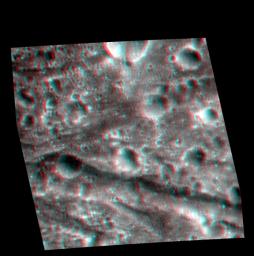
|
The Pantheon in 3-D
- Click the image above for a larger view
- Full-Res JPEG (1270 x 1278) (173.3 kB)
- Full-Res TIFF (1270 x 1278) (4.9 MB)
Caption:
The interior of the Caloris basin has undergone complex tectonic modification . The prominent graben towards the bottom of the image lies just south of the crater Apollodorous near the center of Caloris . It is one of the largest graben in Pantheon Fosse .
This image pair was acquired as a targeted set of stereo images. Targeted stereo observations are acquired at resolutions much higher than that of the 200-meter/pixel stereo base map. These targets acquired with the NAC enable the detailed topography of Mercury's surface to be determined for a local area of interest.
Date acquired:
April 19, 2014
Image Mission Elapsed Time (MET):
40199375, 40199548
Image ID:
6151740, 6151745
Instrument:
Narrow Angle Camera (NAC) of the Mercury Dual Imaging System (MDIS)
Center Latitude:
28.61°
Center Longitude:
163.1° E
Resolution:
35 meters/pixel
Scale:
The large graben going from left to right across the scene is approximately 40 km (25 mi.) long.
Incidence Angle:
36.1°, 36.0°
Emission Angle:
32.7°, 23.7°
Phase Angle:
50.4°, 30.3°
North is to the left in this image.
Background Info:
The MESSENGER spacecraft is the first ever to orbit the planet Mercury, and the spacecraft's seven scientific instruments and radio science investigation are unraveling the history and evolution of the Solar System's innermost planet. During the first two years of orbital operations, MESSENGER acquired over 150,000 images and extensive other data sets. MESSENGER is capable of continuing orbital operations until early 2015.
For information regarding the use of images, see the MESSENGER image use policy .
Cataloging Keywords:
| Name | Value | Additional Values |
|---|---|---|
| Target | Mercury | |
| System | ||
| Target Type | Planet | |
| Mission | MESSENGER | |
| Instrument Host | MESSENGER | |
| Host Type | Orbiter | |
| Instrument | Mercury Dual Imaging System (MDIS) | |
| Detector | Narrow Angle Camera (NAC) | |
| Extra Keywords | Color, Crater, Map, Radio | |
| Acquisition Date | ||
| Release Date | 2014-10-29 | |
| Date in Caption | 2014-04-19 | |
| Image Credit | NASA/Johns Hopkins University Applied Physics Laboratory/Carnegie Institution of Washington | |
| Source | photojournal.jpl.nasa.gov/catalog/PIA18766 | |
| Identifier | PIA18766 | |
